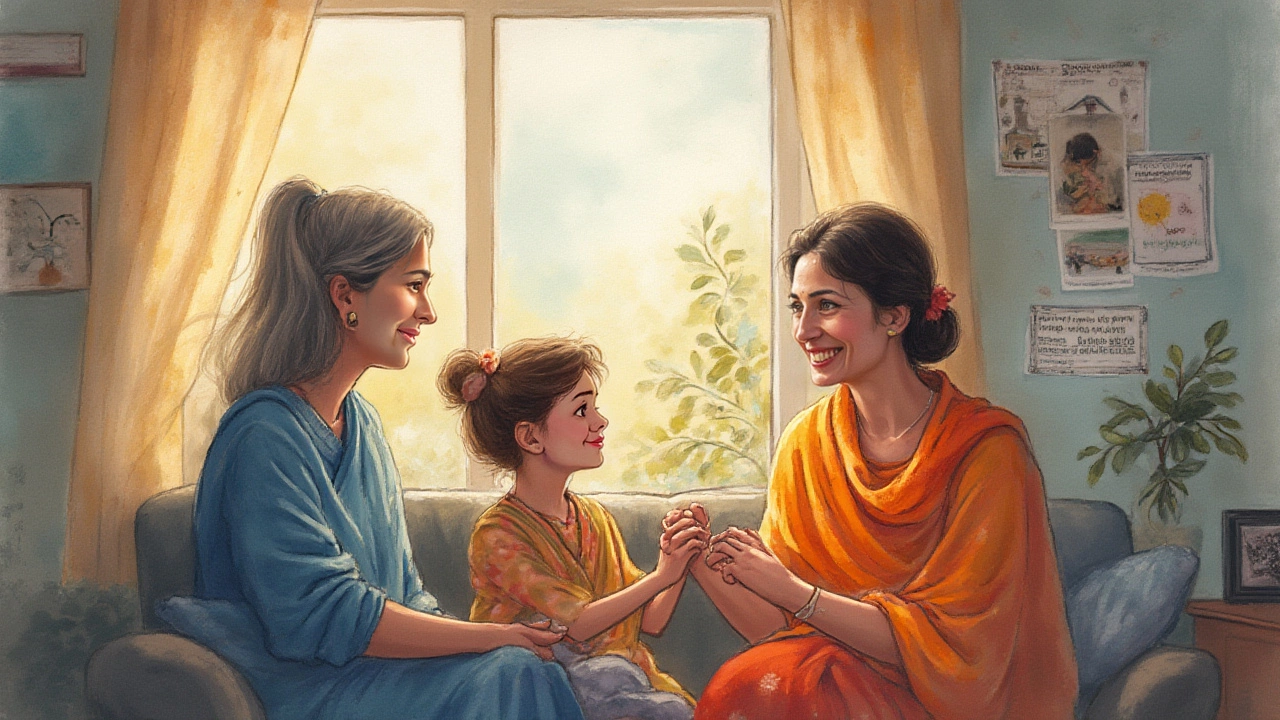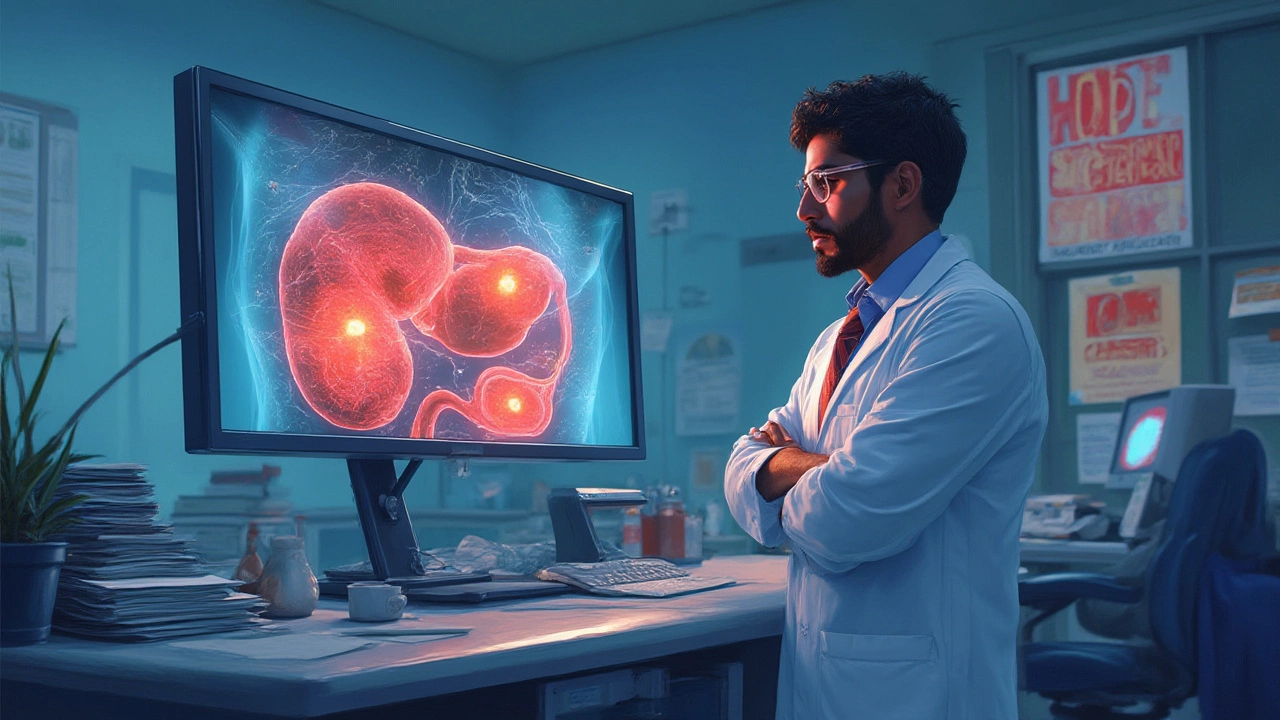If you’re wondering which cancer scares doctors, patients, and researchers the most, here’s a sobering fact: pancreatic cancer has the lowest survival rate among major cancers, and it still counts as one of the deadliest diagnoses out there. Let’s not sugarcoat it—while other types, like breast or prostate cancer, have shown huge leaps in treatment and survivorship, pancreatic cancer has barely budged in decades. Its five-year survival rate hovers around 12%, according to the American Cancer Society's latest stats. Compare that to breast cancer, which currently boasts a five-year survival rate above 90%, and the gap says it all. So, what’s going on with this disease that makes it so stubborn?
Why Pancreatic Cancer Is So Hard to Cure
First, pinpointing pancreatic cancer early is almost impossible. The pancreas sits deep in the belly, buried behind other organs. Most people have no clue anything’s wrong until the cancer spreads beyond the pancreas. Early symptoms? There basically aren’t any. When symptoms finally show up—things like back pain, jaundice, weight loss—it usually means the tumor has grown or traveled elsewhere. In fact, by the time most people get diagnosed, nearly 80% already have advanced or metastatic disease.
Now, about treatment. The three go-tos for any solid tumor are surgery, chemotherapy, and radiation. For pancreatic cancer, surgery offers the only real shot at a cure. But only about 15-20% of patients ever qualify for surgery—that means 80-85% are too advanced or the tumor is wrapped around critical blood vessels. Even if you catch it "early," it’s a tough operation. Whipple surgery, the main procedure, is infamous for being one of the trickiest out there. Surgeons remove part of the pancreas, some of the small intestine, the gallbladder, and part of the bile duct. Tougher still, lots of patients aren’t healthy enough for such a huge surgery in the first place, since the disease makes them weak and they’re often diagnosed at an older age.
Chemotherapy? Sadly, pancreatic cancer cells are stubborn. The pancreas is surrounded by thick, tough tissue (called stroma) that acts like a shield. This fortress makes it hard for drugs to even reach the tumor. There’s also something especially sneaky about the biology of these cancer cells—they seem to shrug off chemo and radiation more than other cancers. Immunotherapy, which is saving lives in melanoma and lung cancer, barely works for most pancreatic cancers. Researchers are still baffled by this cancer’s almost magical ability to resist treatment.
Let’s put these challenges in perspective with some numbers in a simple table:
| Cancer Type | 5-year Survival Rate (%) | Median Age at Diagnosis | Surgical Candidates (%) |
|---|---|---|---|
| Pancreatic | 12 | 70 | 15-20 |
| Breast | 91 | 62 | More than 80 |
| Prostate | 97 | 66 | More than 90 |
| Colon | 65 | 68 | More than 75 |
The table makes it clear—this disease is a different beast. There’s also a genetic angle to consider. About 10% of pancreatic cancer patients have an inherited mutation (like BRCA). This may let some get certain targeted drugs, but for most patients, those options are off the table.
So, why isn’t there a simple blood test or scan to catch it early? Part of the answer is scientific: there’s no unique marker in the blood that shows up reliably enough. There’s a blood marker called CA 19-9, but it’s hit or miss and can be high in other non-cancerous conditions too. Plus, most people don’t get routine scans of the pancreas unless there’s a family history or very strong symptoms, and it stays out of the spotlight until too late. If you have pancreatitis, diabetes, or certain rare genetic syndromes, you’re more at risk, but even then the absolute risk stays pretty low for most.
One thing that frustrates scientists: the cells in the pancreas don’t die or mutate in predictable ways. Tumors can form almost anywhere in the pancreas, making each patient’s diagnosis and outcome a bit different. Some people have slow-growing tumors, but most types act aggressively, moving to the liver or lungs early. It’s not only a matter of location, but of pure unpredictability, which makes doctors’ jobs even tougher.
Calling pancreatic cancer "tricky" feels like an understatement. Try "stealthy and relentless." The puzzle here isn’t just late detection–it’s also about a disease that seems to resist most modern medical tricks, leaving researchers and patients in a race against time.

Outliers: Other Cancers That Are Incredibly Hard to Treat
Pancreatic cancer deserves its harsh reputation, but it’s not alone. Some other cancers, like glioblastoma (the nastiest brain tumor), have terrible survival rates too. Glioblastoma hangs around the 5% five-year survival mark. The story there? Tumor cells snake through healthy brain tissue, blending in and making it nearly impossible for surgeons to get every piece. Radiation and chemo only slow it down for a while. Then, there’s some forms of ovarian, liver, and esophageal cancer that also have pretty grim stats, especially if caught late.
Lung cancer, especially small cell type, kills more people than any other cancer worldwide, partly because it’s caught late and spreads fast. Imagine this: more than 60% of lung cancer diagnoses happen after the disease has spread outside the lungs. That makes surgery mostly off-limits, and treatment focuses on slowing it down, not curing it. Liver cancer? The numbers have been climbing, mostly due to hepatitis and fatty liver disease, and it sneaks up on people with very few warning signs.
Here’s a quick rundown of these tough cancers and why they’re so challenging:
- Glioblastoma: Rapid growth in the brain, hard to remove fully, comes back fast.
- Ovarian Cancer: No real early warning symptoms, and no good screening test exists.
- Esophageal Cancer: Linked to smoking, drinking, or acid reflux; discovered late when swallowing becomes hard.
- Small Cell Lung Cancer: Strong link to tobacco; extremely aggressive and spreads early.
- Liver Cancer: Common with chronic hepatitis or cirrhosis; treatment options depend heavily on liver function.
If you take a look at cancer survival data, the trend jumps out: the more hidden the organ and the fewer symptoms, the harder it is to treat. Cancers that don’t "announce" themselves tend to go undetected until they’re beyond control. And unlike breast cancer, where early detection is possible, with these types, even the best screening tools lag behind.
Another thing—all cancers aren’t the same, even within the same organ. For example, pancreatic neuroendocrine tumors (Steve Jobs had this type) are slower to spread than the classic pancreatic adenocarcinoma, but both are tough to treat. Some rare blood cancers, like certain types of leukemia, can also be difficult but have seen more progress in the last decade.
Here’s something crazy: researchers have mapped the entire genetic code of several tough cancers, hunting for what makes them tick. Sometimes, they’ve discovered “driver mutations” that drugs can target. But, for pancreatic and brain tumors, the mutations are either too varied, too rare, or too embedded in normal cell functions to hit with current drugs. It’s as if the tumor is hiding its "off switch."
Lifestyle factors play a piece, but not always the way people think. For liver and lung, tobacco and alcohol are clear-cut risks. For pancreatic, smoking is a risk, along with obesity and older age, but even people with no obvious risk can develop it. It’s not as simple as "do this and you’ll avoid it," which makes prevention advice much trickier.
So, despite all the hype around new "miracle cures," these toughest cancers—pancreatic, brain, certain ovarian, liver, esophageal—remind us how far medicine still has to go. They force the research community to stay humble and relentless, searching for that breakthrough.

Hope on the Horizon: New Research and Tips for Patients
Now, it’s not all doom and gloom. The fight against the hardest cancers is fierce, and there’s been a real surge in energy around cracking the pancreatic cancer code. Scientists are investing heavily in early detection tools, like blood-based "liquid biopsies" that search for tiny fragments of cancer DNA. This kind of test could, if perfected, catch pancreatic cancer years before symptoms begin—giving patients a real fighting chance. Right now, these tests are mostly in the research stage, but some are available in big academic centers for very high-risk patients with family history or certain gene mutations.
There’s also action on the treatment front. Combination chemotherapy regimens, like FOLFIRINOX (not exactly a household name, I know) have bumped up survival numbers by a few months for some patients. It’s a small win, but a real one. Immunotherapy is starting to get tweaks so it works better for stubborn tumors, and researchers are testing precision medicine by using the genetic profile of a person’s tumor to pick out targeted drugs. For example, if someone has a BRCA mutation, a drug called olaparib—used in breast and ovarian cancer—can sometimes work wonders for pancreatic tumors.
The biggest shifts might come from basic science labs—guys and girls in white coats hunting for ways to break down the stroma fortress, or force cancer cells out of hiding. There’s serious hope that the first effective screening test is just a few years away, and during trials, some new drugs have shown early promise in shrinking tumors.
For patients and families, what really helps? Here are some practical tips based on what doctors and survivors say works:
- If you’ve got a family history of pancreatic or ovarian cancer, talk to your doctor about genetic counseling and risk assessment. Knowing your risk can be a game changer.
- Avoid tobacco and keep a healthy weight—the only two risk factors you can actually control with pancreatic cancer. There’s no magic diet, but Mediterranean-style eating helps keep the body strong.
- If you suddenly get diabetes after age 50, especially with no family history, let your doctor know. It’s rare, but sometimes new diabetes might be an early symptom of pancreatic tumors.
- Don’t ignore yellowing of the skin or unexplained back pain—get checked, even if you think it’s just from working out or a nagging injury.
- For patients diagnosed with tough cancers, seek care at centers with lots of experience—big teaching hospitals or specialty cancer centers tend to have more options and access to clinical trials.
- Stay plugged into the latest research. New clinical trials for drugs, immunotherapy, or even personalized vaccines are opening every month.
- Support groups and counseling can help you keep your mental game strong. This is not a solo fight.
Sometimes I think about how my golden retriever Simba bounces back from minor health scares—he has a way of looking forward, not back. That’s something that keeps families fighting alongside loved ones with tough cancers: hope for the next breakthrough, clinging to every edge, no matter how small. While pancreatic cancer and its fellow “hardest to cure” types still haunt the cancer world, progress is happening, often in quiet labs or breakthrough studies you only hear about months later.
There’s no magic bullet yet, but the landscape’s shifting step by step. For now, knowing the facts, catching any red flags early, and tapping into support and new research puts you or your loved ones in the best spot to face even the trickiest cancer with as much strength and hope as possible.
